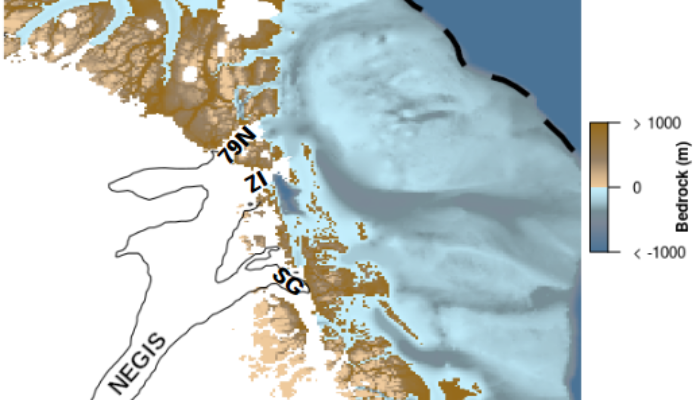
Recent geological data shows that during a very cold phase of our Earth’s climate (between 40,000 and 26,000 years ago), there was a huge expansion of polar ice sheets, yet the north-eastern part of the Greenland ice sheet was less extensive than today. How could this have occurred? In this post we shed light on the potential causes of this ice sheet behaviour.
What do we know about present-day north-east Greenland?
The North East Greenland Ice Stream is one of the most interesting icy features of the present-day Greenland Ice Sheet. Extending for more than 600 km from the ice-sheet interior to the ocean, this ice stream drains almost 12% of the whole ice sheet and terminates through a system of fast-flowing outlet glaciers, known as Nioghalvfjerdsfjorden glacier (also called 79N), Zachariae Isstrøm and Storstrømmen (Fig. 1).
These three outlet glaciers belong to the disappearing category of marine-terminating glaciers, i.e. glaciers flowing into the ocean that possess an ice tongue (or small ice shelf) floating on the seawater. These tongues are connected to the main trunk of the glacier that is grounded over the continent, and the zone where the glacier starts to float is called the grounding line. The grounding line can move forward (or backward) if the glacier gains (loses) sufficient mass and can then expand (or retreat).
But how can a glacier gain mass? This is possible if the glacier mass balance is positive, i.e. if the glacier accumulates more ice (through snow precipitation) than is melted away (through surface and basal melting). Therefore, if surface air or oceanic temperatures increase, the glacier will likely lose mass, reducing its floating tongue and potentially making the grounding line retreat.
Recently, the 79N and Zachariae Isstrøm glaciers have lost a huge amount of ice mass via this mechanism due to rising temperatures. This suggests that this part of the ice sheet is very sensitive to climate change. Under a warmer climate, these glaciers could even lose their whole floating tongue, potentially causing irreversible consequences to the stability of the region.
How did north-east Greenland behave in the ancient past?
On millennial timescales, the north-east Greenland has had a very animated past too. Understanding the history of polar ice sheets requires a lot of effort both collecting and analysing paleoclimatic data (i.e. data archives providing information on the past evolution and climate of the ice sheet, e.g. from ice cores, marine sediments, …), which are usually very sparse, and running numerical simulations. Thanks to both disciplines, we know today that during the last glacial period (when Homo Sapiens were still in the Stone Age), the north-eastern part of the ice sheet expanded by hundreds of kilometers away from the coast into the ocean. During its maximum phase (in the Last Glacial Maximum, 21,000 years ago), this north-eastern part very likely reached the continental shelf break, the edge of shallow waters (see Fig. 1). However, very little information is available on the evolution of north-east Greenland before the Last Glacial Maximum.
One of the most interesting contribution to this gap in knowledge came less than two years ago from a group of researchers headed by Dr. Nicolaj Larsen, who ran an expedition at 79°N for new evidence. They focused their research on marine material found on moraines (eroded material deposited by the glacier). There, they collected and dated fragments of marine shells and were able to pinpoint when the moraines were formed, indicating the timing of glacier retreat. Their new data suggested that these moraines were a few thousand years older than the Last Glacial Maximum, meaning that the edge of Zachariae Isstrøm was located at least 20 km upstream of its current position at that date (Fig. 2, right).

Fig. 2: Left: Sample site at Zachariae Isstrøm [Credit: Supplementary Material of Larsen et al., 2018]. Right: Reconstruction of the North East Greenland Ice Stream grounding line distance from its present-day position for the last 45,000 years in the Marine Isotope Stage 3 (MIS-3) and Last Glacial Maximum (LGM) [Credit: I. Tabone, data from Larsen et al., 2018].
How could north-east Greenland be less extensive than today during a cold climate?
How could it be possible that these glaciers were less extensive than today, despite the cold, dry climatic conditions during the last glacial period? Well, it is a complex story! We are actually talking about a glacial time interval called Marine Isotope Stage 3 (~ 60,000-25,000 years ago), a period studded with several rapid abrupt climate events in which polar latitudes received larger incoming summer radiation than during the rest of the glacial period.
During Marine Isotope Stage 3, summer air temperatures were about 6 to 8ºC higher than during the Last Glacial Maximum (Fig 3, middle panel). This is likely due to long-term variations in incoming solar radiation associated with changes in the Earth’s orbit. Marine Isotope Stage 3 was also very dry, with low accumulation (snowfall) rates in northern Greenland (Fig 3, low panel). These warm temperatures and low accumulation could be a possible explanation for the expansion of the north-east Greenland ice sheet during Marine Isotope Stage 3 (Larsen et al., 2018). However, summer air temperatures at high latitudes were still well below 0°C during this time, so it is unlikely that they could have strongly affected ice mass loss in the region. The conclusion is: the atmosphere alone probably could not be the only climatic driver of this strong ice fluctuation at 79°N.

Fig. 3: Grounding line (GL) distance from the present-day (PD) position (a); summer temperature at 79N (b); accumulation rate at North Greenland Eemian Ice Drilling (NEEM) ice-core site [Credit: I. Tabone, data from Rassmussen et al., 2013, figure inspired from Larsen et al., 2018].
So it’s not the atmosphere… What about the ocean?
As the ocean has been recently argued to have an important role in the present-day retreat of the North East Greenland Ice Stream (see this study, this one and this one), it is reasonable to think about the ocean as a possible player in this large past fluctuation. Thanks to a 3D ice-sheet model, we performed simulations of north-east Greenland evolution in the past to assess how sensitive the ice-sheet margins were to variable oceanic conditions during the last glacial cycle. We represented these different oceanic states in the model by imposing melt at the grounding line and at the ice-shelf bases (also called submarine melt). Past submarine melt rates are inferred from past oceanic temperatures changes, because any increase in oceanic temperature results in increased submarine melting. Over long-term timescales, this means submarine melt rates were higher during Marine Isotope Stage 3 compared to during the Last Glacial Maximum.
Results of these model runs are pretty neat: with sufficiently high submarine melting along its margins, the North East Greenland Ice Stream retreats several tens of kilometres upstream from its maximum glacial position. Importantly, this suggests that increasing oceanic temperatures during Marine Isotope Stage 3 could have driven this large instability in the north-eastern ice-sheet margin during the last glacial. This is likely to have caused large reorganisations of the entire region and major ice discharge into the ocean (here is an animation showing the modelled north-east Greenland evolution during the last 45,000 years).

Fig. 4: Evolution of the north-east Greenland grounding-line (GL) distance from its present-day (PD) position simulated by our ice-sheet model. The model was run with no submarine melting (red line) and with progressively higher melting (other coloured lines). The dashed black line shows the reconstruction by Larsen et al. (2018). The three horizontal black dotted lines show the today’s NEGIS grounding-line position (0 km) and the maximum (300 km ± 50 km) reconstructed advance of the north-east Greenland during the Last Glacial Maximum according to Funder et al. (2011) [Credit: I. Tabone].
More investigation is needed!
Today we are aware that the north-east Greenland ice sheet is one of the most vulnerable regions of the ice sheet to current climate change. Figuring out its past evolution will help to understand its behaviour in a warming world, and its importance in the future stability of the entire Greenland ice sheet. However, as our study is the first attempt to look at the causes of this anomalous retreat from a modelling point of view, further work is needed and many questions are still unanswered. Was the ocean the major player in this past fluctuation? To what extent were surface air conditions also a factor? How much abrupt atmospheric warming events have influenced this margin fluctuation at smaller timescales? Further modelling work and observations at the North East Greenland Ice Stream are needed to unravel this icy riddle…
Further reading
- Tabone et al. (2019): Submarine melt as a potential trigger of the North East Greenland Ice Stream margin retreat during Marine Isotope Stage 3, The Cryosphere, 13, 1911–1923.
- Larsen et al. (2018): Instability of the Northeast Greenland Ice Stream over the last 45,000 years. Nature Communications; 9 (1), 2018.
- Funder et al. (2011): Chapter 50 – The Greenland Ice Sheet During the Past 300,000 Years: A Review, Developments in Quaternary Sciences, 15, 699-713.
- Rasmussen et al. (2013): A first chronology for the North Greenland Eemian Ice Drilling (NEEM) ice core, Clim. Past, 9, 2713–2730.
- Geosciences Column: How fast are Greenland’s glaciers melting into the sea?
- Image of the Week – Petermann Glacier
- Paleoclimatology data
- Ice cores for dummies
- Cruising for mud: Sediments from the ocean floor as a climate indicator
Edited by Jenny Arthur and Clara Burgard
 Ilaria Tabone is a Postdoc Researcher at the University Complutense of Madrid (Spain) in the Paleoclimatic Analysis and Modelling (PalMA) research group. She investigates the evolution of the Greenland Ice Sheet in the past glacial-interglacial cycles by working with ice-sheet models of continental scale. Her research focuses on ice-ocean and ice-atmosphere interactions. Contact Email: itabone@ucm.es
Ilaria Tabone is a Postdoc Researcher at the University Complutense of Madrid (Spain) in the Paleoclimatic Analysis and Modelling (PalMA) research group. She investigates the evolution of the Greenland Ice Sheet in the past glacial-interglacial cycles by working with ice-sheet models of continental scale. Her research focuses on ice-ocean and ice-atmosphere interactions. Contact Email: itabone@ucm.es

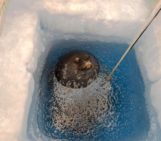
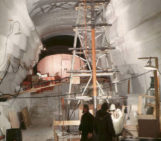
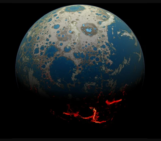
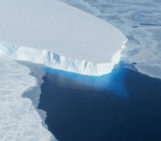
홀덤뉴스
The North East Greenland Ice Stream (NEGIS) is a truly remarkable feature of the Greenland Ice Sheet